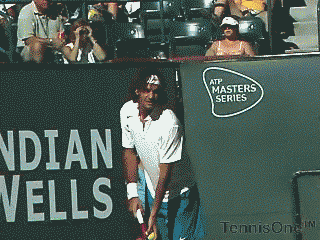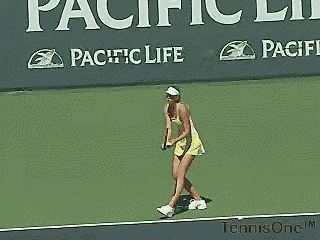|
TennisOne Lessons Australian Open - It's All about the Second Serve Jim McLennan
As Roger Federer and Serena Williams swept to victory, both matches were ruled by the serve. In the men's final, Gonzalez served reasonably well, but was unable to do anything against Federer's delivery. In the women's lopsided final, Serena served extremely well, but Maria had recurring problems with her delivery, and paid dearly. And in this instance it led to many one and two shot rallies. Serena's deadly serve was often unreturnable. Maria's second serve, on the other hand, was often returned for outright winners. A look at the match statistics reveals interesting parallels (and they have been underlined).
To my eye, both matches hinged on the serve. Larry Stefanki remarked that Gonzo couldn't read the Federer toss as he had been able to do in earlier matches, and the disguise in Fed's delivery is reflected in the incredible percentages of winning points on both his first and second serves. The match was punctuated by incredible shot making on both sides of the net, but the tale of the tape was clearly the serve and return. In the women's match, I find it incredible that Sharapova served at 51% on her first serve, offered 6 doubles faults, and won just 26% of the points on her second serve. Further, using the Australian Open serve statistics on second serve placement, in the deuce court, Maria served wide twice and to the middle of the box twice, in the ad court she served to the "T: three times and to the middle of the box 8 times. Perhaps Maria was trying to keep it from Serena's backhand, but to me this looked like an unfortunate example of a server without the confidence (or skill) to fire the ball into the corners.
The serve and confidence are inextricably linked. When serving well, we tend to become more confident, when serving poorly, one's entire game can and often does go into the tank. And on the other hand, when confident, we tend to serve better. In the men's finals, after Federer captured the first set, his serve percentages improved markedly. But let's take a look at Maria's serve. The author is by no means an expert on the serve, but there are a number of features that may be contributing to her difficulties. Luke Jensen said that Michael Joyce and Maria's father Yuri worked at length on Maria's serve just before the finals. Their intent was to have Maria "swing up" and "keep her head up." I have looked through our pro strokes footage and I find examples of Maria doing just that (and presumably serving well) and examples when she is pulling both her head as well as her swing down. The question for me remains, is this "down thing" a symptom or a cause. I believe it is a symptom, and cannot be treated much less corrected until causes earlier in her motion are addressed. Sampras and Federer (and even Serena) do not move their feet during the serve and both appear to cartwheel up and into the hit. Further, both men use relatively low tosses, where the motion is continuous and fluid. If you pick a spot on the back fence to reference the top of Roger's head, you notice that his head was moving up a moment before impact, and his head peaks (much like a ball tossed up in the air) at impact. Compare and contrast that motion with the deliveries of Maria and Venus, where both move their feet, both use overly high tosses, and both bend forward at the waist during the hit (rather than cart wheeling up). When serving, the delivery should be balanced, fluid, and rhythmic, and everything should be about moving up and hitting up and into the ball. Certainly that can be said of Serena and of Roger. But the closer you look at Maria and Venus (because they have so much in common), there appears to be real questions about their balance and their rhythm. Were I to advise Maria or Venus, or you for that matter, I would suggest copying the style of Roger, Pete, or Serena. Keep your feet still during the delivery to improve balance. Lower the toss to improve the rhythm of the swing. And turn your shoulders up and into the hit (cart wheeling) rather than bending forward and down at the waist. I think that would improve Maria's serve, and yours too. Your comments are welcome. Let us know what you think about Jim McLennan's article by emailing us here at TennisOne.
|
||||||||||||||





